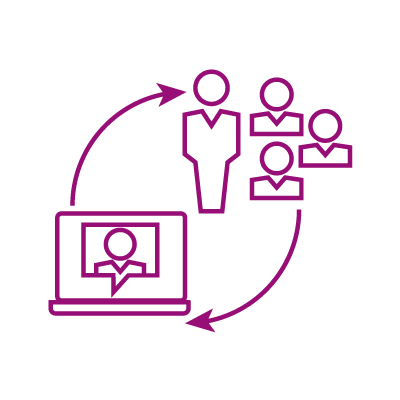It seems like the top barrier to a successful leadership development program has shifted over time. In the past, customers I worked with described obstacles like lack of training rooms, insufficient training budgets, or the absence of executive support. Now, the main barriers have coalesced around one primary challenge: how do we capture leaders’ time and attention amidst the increasingly demanding roles they occupy? One solution that many organizations have adopted is blended learning.
What is blended learning for leadership development?
Blended learning in leadership development involves a mix of in-person learning, like traditional classroom learning, and online experiences. What kind of online experiences? Games, tools, simulations, practice chatbots, and short bursts of learning (microlearning) are just a few examples. And frequently, virtual classroom and various forms of self-paced learning enter the mix.
What’s also unique about blended learning is that the mix of learning can be done alone, in an in-person classroom, or in a virtual classroom group setting.
At its best, blended learning leverages the strengths and efficiencies of each modality, while acknowledging their limitations. The result is a learning program that’s engaging, time and cost efficient, and capable of making a sustained impact.
What are the tools for blended learning?
Let’s take a look at the various tools in our blended learning toolbox and consider where they fit into the overall mix of a blended learning experience. Each of these tools offers unique strengths that the others lack—as well as pitfalls to avoid if overused. Consider these factors as you determine the right blend for your learners.

1. In-Person Classroom Training
The in-person classroom provides more formal opportunities for leaders to receive live, face-to-face instruction. In the past, it has served as the status quo. And the benefits of in-person training are well understood.
It brings learners together in a space specifically designed for learning. They benefit not just from the instruction but from the networking and community-building that come with meeting together in person.
As many companies commit to long-term flexible working arrangements, demand for in-person classroom training has changed. It is, after all, the least flexible modality for leadership development. This form of learning often requires the biggest time commitment from both learners and facilitators. In many cases, travel time and cost factor into the overall investment. This form of learning can also cause companies to miss developing leaders who don’t work close to a training location.

2. Virtual Classroom
Virtual classroom is live instructor-led leadership development over a remote meeting platform like Zoom. It has some of the same benefits as traditional classroom. Breakout discussions and interactivity are still key features—but learners are in the privacy and comfort of their own homes or workspaces.
The virtual classroom has become widely adopted to achieve similar benefits to in-person classroom training. Virtual classroom does, however, often suffer from a branding problem. Some learners still perceive this to be something akin to a webinar (with limited interactivity and engagement). Well-executed virtual classroom training can be just as engaging as in-person training with the right design and facilitation.
Another challenge with virtual classroom training is the need to shorten the training experience. Learners in the virtual classroom tend to prefer somewhat shorter sessions than they do with in-person experiences. And this is where blended learning can help the virtual classroom shine. If foundational concepts can be taught in a short self-paced course as pre-work, the instruction time in the virtual classroom can be reserved primarily for group interaction and discussion.

3. Flipped Classroom
This blended learning format—which may involve in-person or virtual instructor-led training—relies on learners engaging with content on their own ahead of a group session. Then, during the live event, instead of spending time on the more conceptual parts of the learning, learners can immediately begin interacting with content in a more hands-on way. Deep discussions, activities, and skill practice are just a few examples. The flipped classroom maximizes the amount of time spent on the kinds of learning that can only be accomplished when learners are together.
The biggest limitation to flipped learning is the high level of accountability it requires. Learners must engage with the assigned content ahead of their time in the classroom for the best results. If learners skip the pre-work, the facilitator will need to cut into interactive learning to get them caught up.

4. Online Courses
Self-paced online courses are among the most flexible tool in the learning professional’s toolbox. They can be used by anyone anywhere at any time. Also, online courses can create more personalization for learners. Learners can pick the content they feel is most relevant to them.
This form of learning misses out on some of the benefits of learning together. There aren’t opportunities to discuss the learning with peers or practice using new skills together. The positive learning tension that naturally arises in a group setting is not there when learning alone.

5. Microlearning
Microlearning is a subset of online learning where, as the name implies, the content is much shorter. Where online courses may take about an hour to complete, learners can typically complete microlearning in 10-15 minutes.
While longer forms of learning will explore a broad concept (for example, coaching), microlearning will narrow in on a more specific topic (for example, a model for giving feedback for improvement). Due to its short duration, microlearning is often used for just-in-time learning. Microlearning is also frequently used to reinforce or deepen knowledge gained in formal learning.
Microlearning has some of the same limitations and drawbacks as longer online courses. Given its shorter duration, many learning professionals wonder how it fits into their blended learning strategy. How do we use it so it has the greatest impact?
What are blended learning strategies?
DDI partners with clients to design and implement blended learning strategies. While finding the right blended learning approach is unique to each situation, blended learning shines brightest in a learning journey approach.
Different forms of learning have their place, but they work best when you use them systematically. In a learning journey, the various elements of your blended learning strategy support, build upon, and reinforce one another.
Traditional classroom and virtual classroom experiences often serve as effective ways to kick off a learning journey. Why? The face-to-face collaboration can build a sense of purpose for the journey and cohesiveness among the group of learners.
Then, after learners are already committed to and engaged in the blended learning program, it’s safer to introduce elements like flipped learning. And online courses and microcourses often serve as effective intersession activities. When participants know they will be called upon to discuss what they learned in these self-paced modules in the next live session, they engage more deeply with them and retain more.
Best Practices for Building Blended Learning Strategies for Leadership Development
As you choose your blended learning strategies, here are a few best practices:
1. Consider your audience to find the right blend.
Different leader levels have different expectations and learning needs. Aspiring leaders and frontline leaders typically have a greater receptivity to and engagement with self-paced online learning. But mid-to senior-level leaders don’t typically engage with this content as well. They like more interactive forms of leadership development, where they can both learn and build their business network.
2. As you incorporate new learning methods, ensure you link them to your business strategy.
Like any change, introducing new forms of leadership development can be a bit of a shakeup. And, as with any disruption, there is the potential for resistance. One way to combat this is to tie your blended learning strategy closely and explicitly to things that matter to the business.
How do leadership development professionals do this? They frame their blended learning strategy around something visible to all leaders.
This can be a company initiative, a change management process, or a new business strategy. This helps learners to feel that their engagement with blended learning is helping them move closer to their goals. And it’s not just something they have to do on top of their day job.
3. Balance personalization with curation.
One of the joys of blended learning is that it makes it easier to create a more personalized learning experience by leveraging high-quality leadership assessments. As a result, leaders can focus on developing the skill areas where they have the biggest gaps in their knowledge.
Many organizations make the mistake of using a “build it and they will come” strategy for self-paced learning. We can’t expect learners, who exist in a busy and chaotic world, to sort through massive libraries of online content to find what they need. This is where learning paths—informed by leadership assessment—can help direct leaders to the learning most relevant to their needs.
The Benefits of Blended Learning Strategies
Blended learning is one of the most powerful tools in the modern learning and development professional’s toolbox. The key is to avoid thinking about it as a mere tactic for shortening training session length, or even in an event-based way at all.
Rather, effective blended learning describes a learning ecosystem in which the right tools are available to the learner in their moment of need. This might look like taking a microcourse one day to prepare for a difficult conversation. On a different day, it might look like spending more focused time in an instructor-led training for deeper learning and peer networking.
The best blended learning strategies allow us to make development a way of work. We can do this by offering flexible learning solutions and shifting the learning paradigm away from “in-person classroom learning as gold standard” to meeting learners where they are and helping them learn in ways that are appealing and convenient to them.
Mark Smedley is a client relationship manager for DDI. He works with healthcare organizations to design and implement their leadership strategies.
Topics covered in this blog

